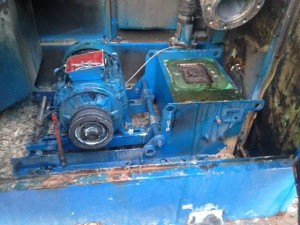At around 8 p.m., a fire broke out on a booster compressor in a factory manufacturing cellulose sponges. Upon detecting smoke coming from the gas scrubber, a technician alerted the site’s designated firefighting personnel (ESI).The firefighters noticed a fire starting in the booster that conveys the neutralizing gases to the scrubber. They were able to bring it under control with the help of fire extinguishers. When the fire brigade arrived, the fire had already been put out.
The flames remained confined to the metal caisson in which the booster was housed. The rubber belt connecting the booster’s drive shaft to the motor’s pulley was burned. When the compressor had stopped, the injection of acid into the neutralisation phase had also stopped, preventing the H2S and CS2 gas fumes remaining in the manufacturing juices from escaping. Production was reduced. The following day, acid was re-injected (calculated to avoid exceeding the emission limit values) and the gases were directed to the stack without treatment. The H2S and CS2 levels measured by chromatography indicated that only an excess of CS2, for which the health risk was reduced. Due to the cold weather (-8 °C), the samples taken at night had frozen and could not be analysed. Following the fire of the previous scrubber, which occurred on 4/08/2015 (ARIA 47002), the operator had not reinstalled the heat tracing cable on the tubes to maintain them at a positive temperature.
The fire was blamed on the booster having been blocked by a foreign object such as blocks of ice that had formed in the external pipes upstream of the booster. The belt, rubbing on the blower’s blocked pulley, eventually caught fire. The fire spread to the compressor’s oil sump.
The booster had been installed in August 2015, after the fire which took place on 4/08/2015. Its maintenance consisted in checking the oil levels. The operator was to replace it with a liquid ring pump on 28/01/2016. As it was already on site, this new pump was installed the day after the accident. Chromatography was once again operational after a temporary system was installed to protect the tubes from the cold. The installation was then restarted at around 4 p.m., and production returned to normal on 22/01.
The operator had planned to reinstall the electrical heat tracing on the chromatography tubes by the end of the month. Several actions were implemented:
- improvement of the training of the security company employees concerning the internal contingency plan and particularly on the alert message procedure;
- creation of an emergency procedures action sheet for the site’s designated firefighting personnel (ESI), which designates an individual in charge of organising the intervention and meeting with the fire brigade. The training of the ESI personnel includes setting up this organisation in an emergency situation;
- checking that the new pump can handle pieces of ice or provide preventive measures to avoid a new accident from occurring (check of the rotation of the pump’s pulleys, insulation of the neutralising effluent line, etc.).




